Key takeaways:
- Editing styles are crucial in photography, allowing for emotional narratives and personal artistic expression.
- A unique editing style distinguishes photographers, creating connections with audiences and building recognizable brands.
- Experimentation with different techniques, such as color grading and minimalism, enhances storytelling and depth in photography.
- Consistent practice and drawing inspiration while maintaining individuality are essential for developing a personal editing style.
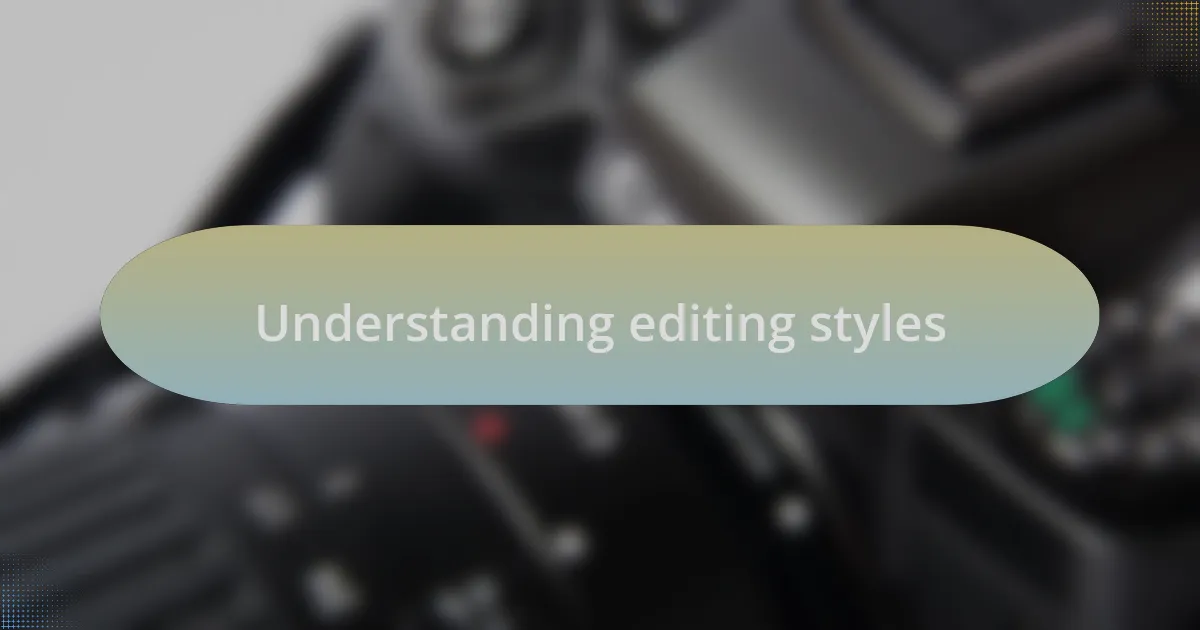
Understanding editing styles
Editing styles in photography are as diverse as the photographers themselves. When I first began experimenting with editing, I found myself drawn to the emotional narratives that certain styles conveyed. Have you ever noticed how a single edit can completely transform the mood of an image? It’s fascinating.
For instance, I remember the day I decided to try a high-contrast black-and-white approach on a portrait I took during a stormy day. The transformation was startling; the shadows deepened, and suddenly the image had depth and drama that I didn’t realize existed. This experience taught me that an editing style can breathe life into your vision, allowing your work to connect on a more profound level with viewers.
Moreover, understanding editing styles isn’t just about the tools or presets you use; it’s about articulating your artistic voice. Each choice, from the color palette to the cropping method, acts as a brushstroke on your canvas. Have you ever felt that surge of excitement when you nail an edit that perfectly reflects how you felt in the moment? That’s the beauty of finding your unique editing style.
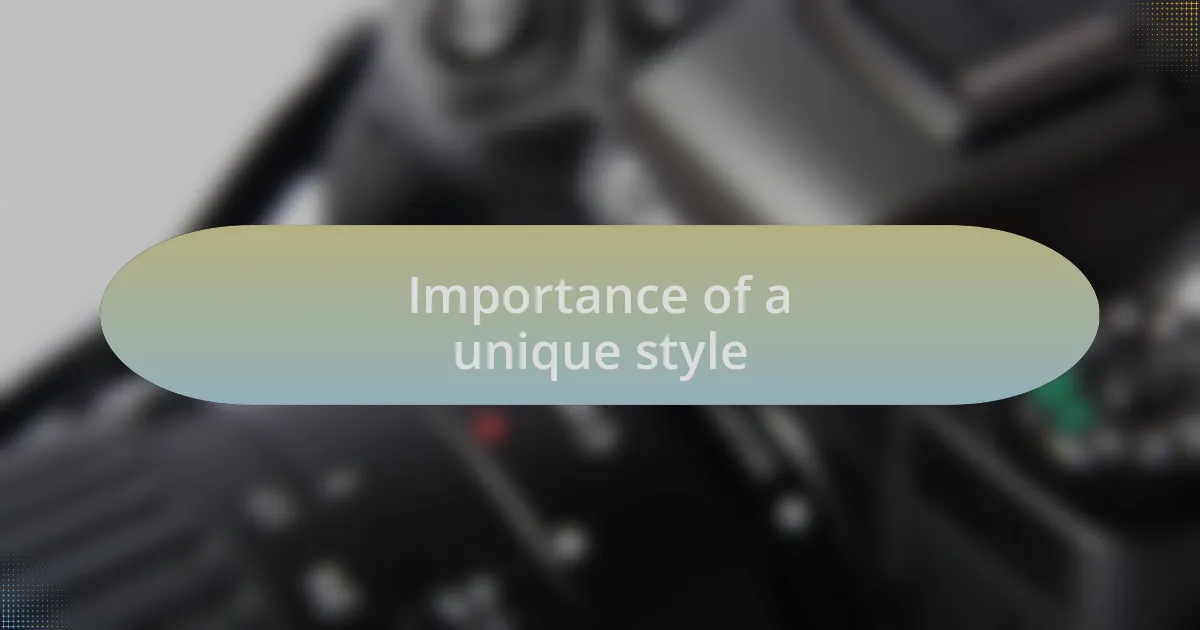
Importance of a unique style
Having a unique editing style is essential in distinguishing oneself in an overcrowded photography landscape. I remember the first time someone recognized my work just by the way I edited my images; it was a thrilling moment that highlighted how signature styles create immediate connections. This recognition fosters not only personal confidence but also builds a recognizable brand that can resonate with audiences.
A distinct style also serves as a visual language that communicates your artistic perspective. For example, when I play with muted colors and soft textures, I aim to evoke a sense of nostalgia and quiet reflection in the viewer. Have you ever looked at an image and felt an unexplainable pull toward it? That’s the power of a unique style; it tells a story, inviting people to explore emotions tied to your experiences.
In a world where everyone can snap a quick photo and apply a trendy filter, originality becomes a rare gem. I strive to remind myself that while trends come and go, a personal editing style can stand the test of time. Think about it: what does your editing say about you? Each decision you make imbues your work with a unique touch that moves beyond mere aesthetics; it becomes an expression of who you are as a creator.
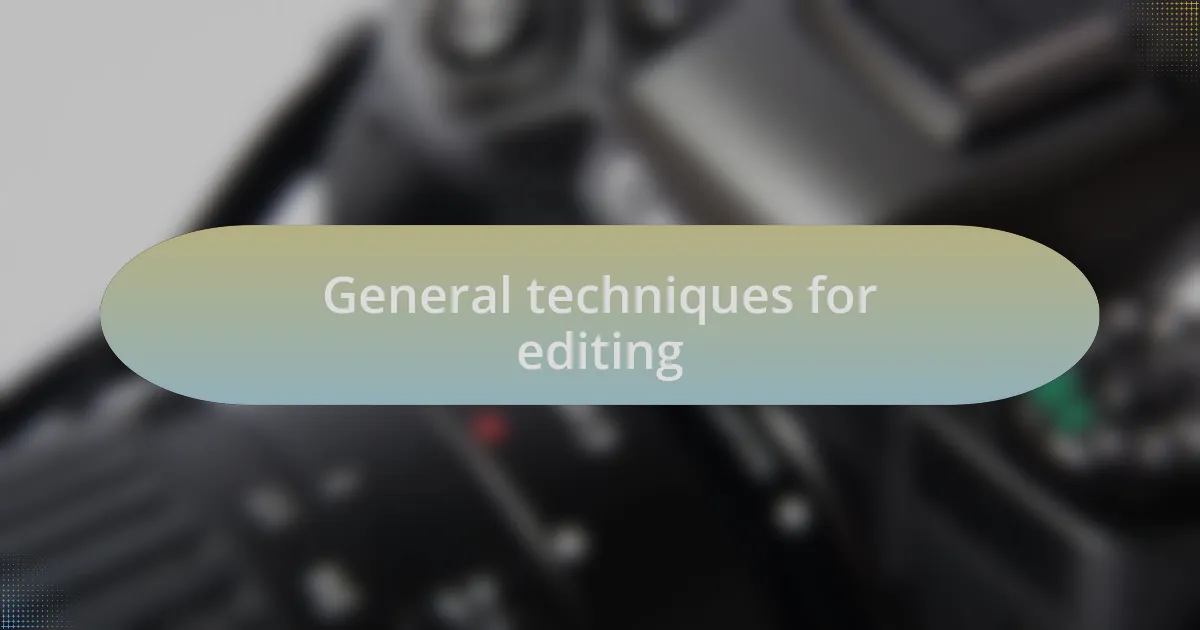
General techniques for editing
Editing is where the magic happens, and there are various techniques I’ve learned along the way that can really transform a photo. One basic technique that I often employ is the adjustment of exposure and contrast. I remember the first time I cranked up the contrast on an otherwise flat image; it felt like bringing a painting to life. This simple tweak can dramatically alter the mood, drawing out details that were previously hidden, and I think you’ll find that experimenting with these adjustments can reveal aspects of your photos you hadn’t noticed before.
I also find that color grading is a powerful tool in my editing arsenal. When I was working on a collection inspired by the golden hour, I selectively boosted warm tones throughout my images. The end result wasn’t just visually stunning; it evoked a sense of warmth and nostalgia that resonated with viewers. Have you ever considered how color can influence the emotions your work conveys? This technique allows for a deeper connection with your audience.
Layering techniques, like using texture overlays, can add depth and interest to your images. I recall experimenting with a subtle grainy texture on a portrait I took; it instantly gave the photo a timeless quality. It’s fascinating how a little creative risk can enhance storytelling in your work. By incorporating textures that resonate with your theme, you can invite viewers to delve deeper into the narrative behind each shot.
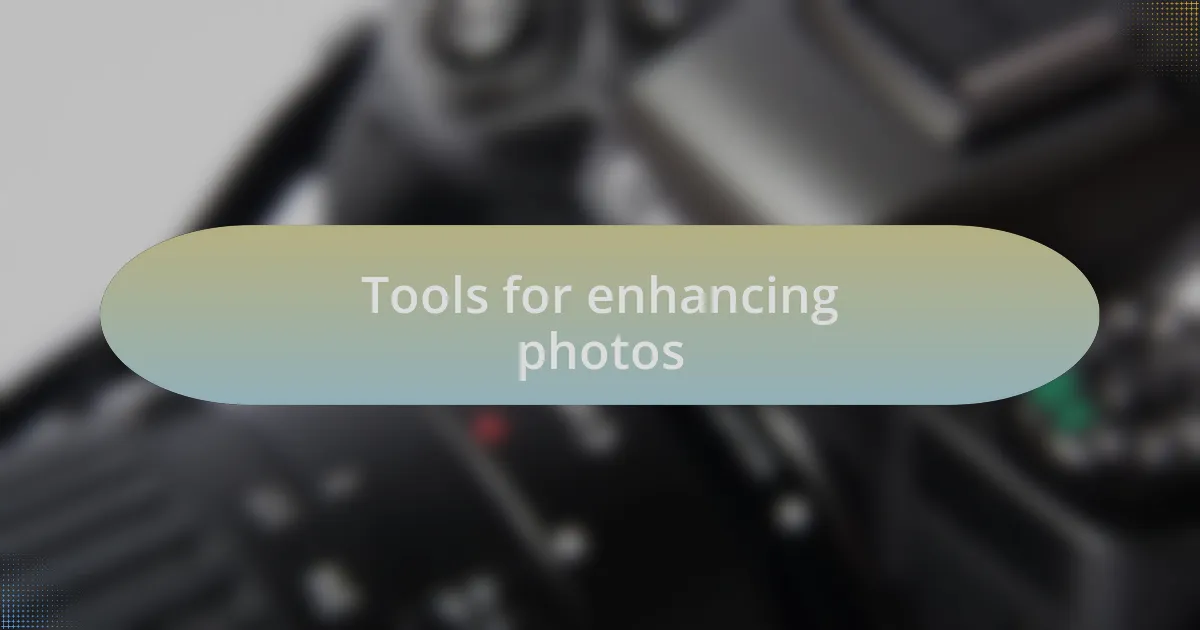
Tools for enhancing photos
When it comes to enhancing photos, I’ve found that software like Adobe Lightroom is indispensable. Its powerful sliders for adjusting sharpness and clarity can elevate an image from merely good to truly outstanding. I still remember the gasps of amazement from my friends when I showcased an image where I sharpened the focus on a subject in the foreground while maintaining a beautifully blurred background. The right tool can make all the difference in drawing attention to what matters most in a photograph.
Another tool that deserves attention is Photoshop, especially for its ability to refine details through retouching. Once, I spent an afternoon using the Healing Brush to smooth out distractions in a landscape shot. The result was a breathtaking vista that feels more immersive and alive, pulling the viewer into the scene. Have you experienced the joy of discovering new details in your images through careful retouching?
I also want to give a nod to mobile editing apps like Snapseed and VSCO, which are surprisingly robust for on-the-go enhancements. I often use these apps during travels when I want to quickly adjust brightness or apply a filter that captures the essence of a moment. There’s something incredibly satisfying about transforming a quick snapshot into a polished image with just a few taps. Have you tried editing directly from your phone? You might be amazed at how effective these tools can be!

Experimenting with different styles
Experimenting with different styles has been a game-changer for my photography journey. I remember the first time I tried a moody, low-key aesthetic. It was a radical shift from my usual bright and airy look, and I was nervous about how it would be received. Capturing shadows and deep tones opened up a new emotional depth in my images that I didn’t know was possible. Have you ever taken a leap into a style that felt completely outside your comfort zone?
As I explored various editing styles, I found myself gravitating towards vintage film aesthetics. I started using presets that mimicked the soft grain and muted colors of old photographs. One particular edit, where I applied a warm sepia tone to a family portrait, elicited nostalgic feelings from everyone who saw it. Seeing the smiles of my loved ones as they reminisced made me realize that some styles can evoke powerful emotions. Isn’t it fascinating how color and texture can transport us back in time?
In contrast, I also delved into high-contrast black-and-white photography, which taught me to view scenes differently. One day, I captured an urban landscape that seemed mundane in color. However, converting it to black-and-white brought out striking lines and shapes, breathing new life into the composition. It was an exhilarating moment when I saw the image transform into something almost sculptural. Have you tried stripping away color to reveal the essence of a scene? It might just change your perspective.
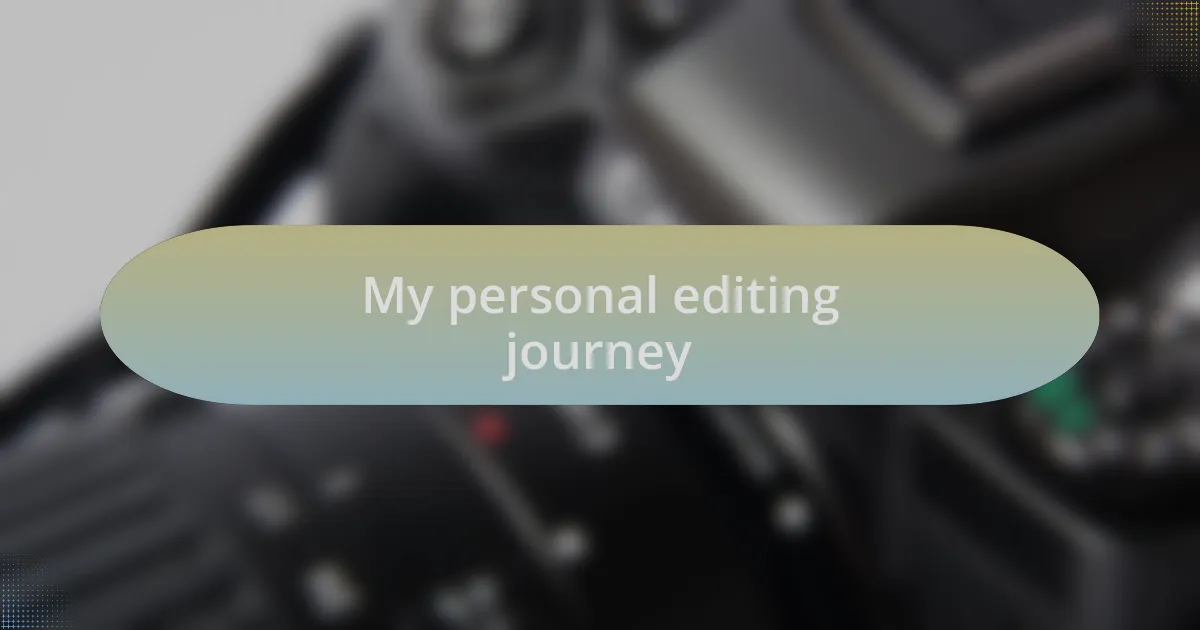
My personal editing journey
As I continued my editing journey, I discovered the world of color grading and its ability to set the mood of a photograph. There was a moment when I edited a sunset picture that seemed dull; by enhancing its oranges and purples, I transformed it into a breathtaking image that reflected the awe I felt while capturing it. Have you ever played with color in a way that completely changed your perception of a moment?
Another pivotal experience for me was when I experimented with minimalism in editing. I took a close-up shot of a flower and stripped away distractions. I remember feeling a rush of satisfaction when I realized the simplicity highlighted the intricate details and textures that would have gone unnoticed otherwise. Isn’t it incredible how sometimes less truly is more in photography?
Finally, I learned the importance of storytelling in my edits. I vividly recall working on a series of travel photos from a recent trip; I added subtle vignetting and enhanced the shadows to create a dreamy effect. This editing style not only tied the series together but also evoked the sense of adventure I felt during the trip. How does editing your images help you narrate your own story?
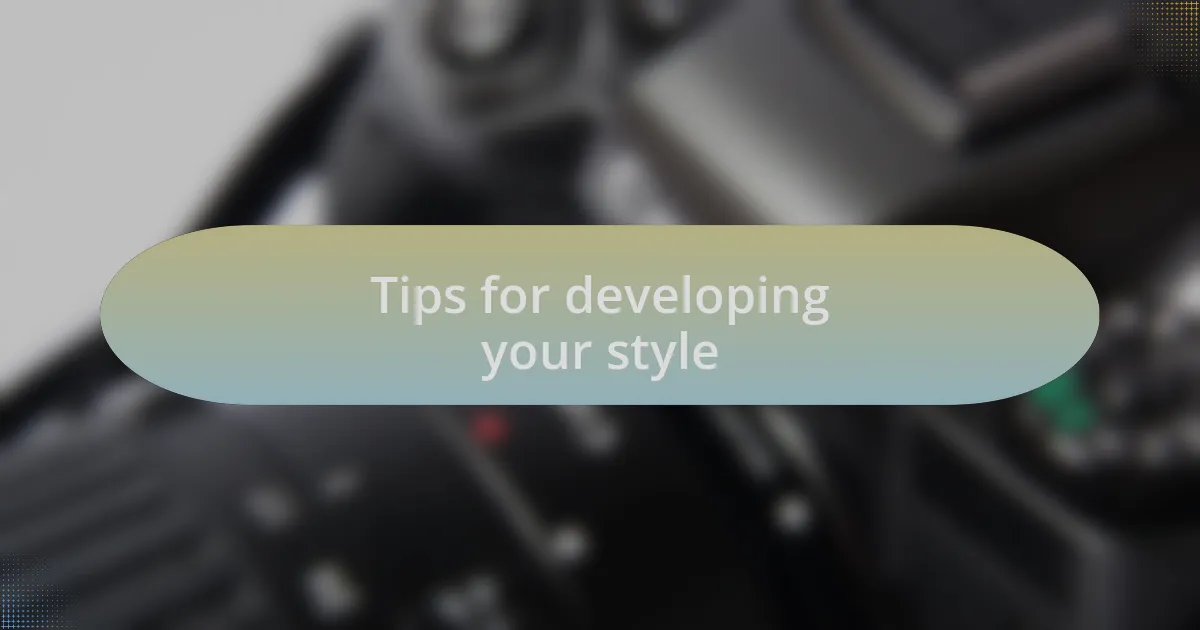
Tips for developing your style
When developing your unique editing style, consider experimenting with different techniques to find what resonates with you. I often play with varying contrasts and exposure to bring out the essence of a photo. I remember one rainy day, I darkened the skies in my landscape shot, which dramatically amplified the drama of the scene. Have you tried adjusting the mood of your images by manipulating light and shadow?
Finding inspiration in others’ work can be incredibly beneficial, but it’s essential to ensure your voice shines through. I once emulated a favorite photographer’s style, but I soon realized that while the result was beautiful, it didn’t feel authentically me. The moment I embraced my preferences, such as a penchant for softer, pastel tones, I felt much more connected to my creations. How do you express your personality in your edits?
Lastly, keep a consistent routine for editing to refine your style over time. I started setting aside time each week to revisit older images and edit them with fresh eyes. This practice helped me notice trends in my choices and developed a clearer style. Have you ever looked back on your previous edits and realized how much you’ve evolved?